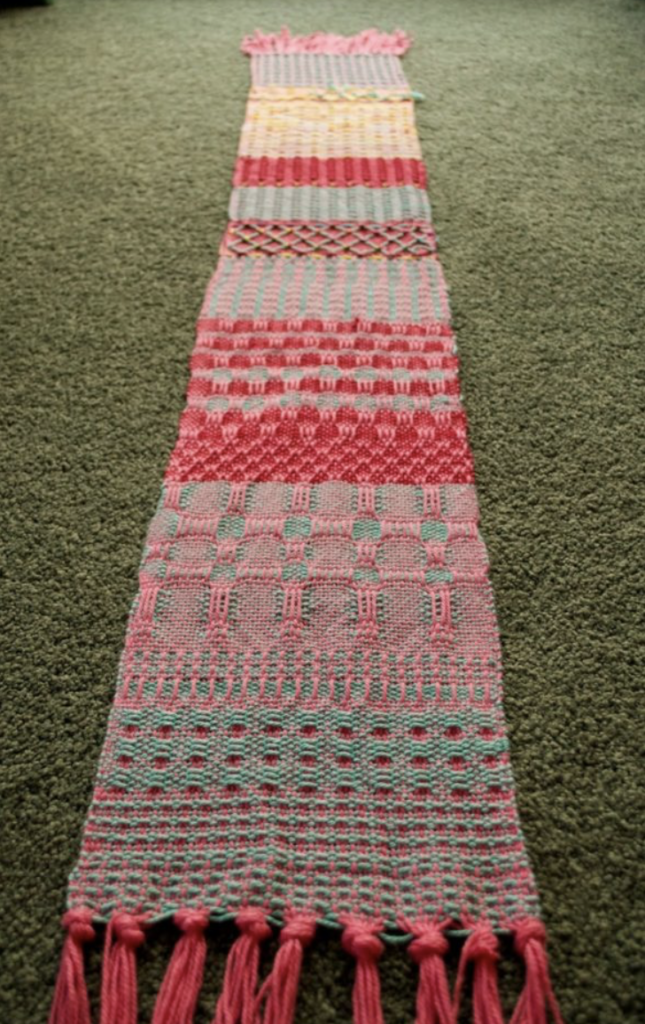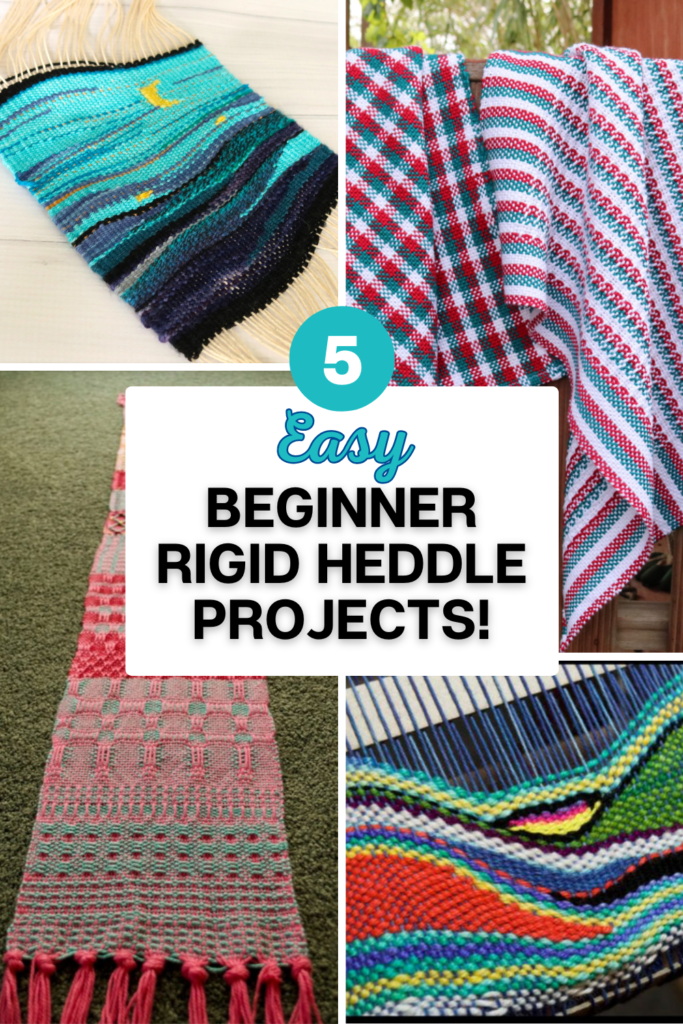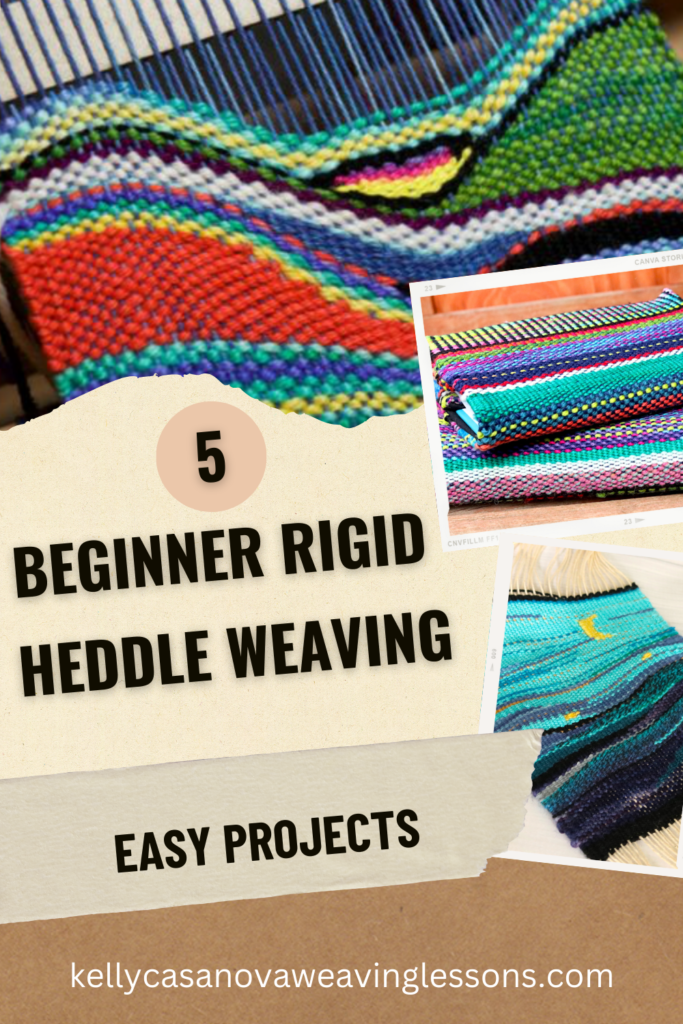Getting your very first rigid heddle loom is such an exciting experience! There are so many possibilities but at the same time, so much to learn.
It’s important to choose projects that are going to be suitable for your weaving level. Be realistic, we all start as absolute beginners and it makes sense to start with an easy project.
This will help you to start to get to know your loom without the stress and pressure of needing to weave at an advanced level.
Here is a list of 5 easy rigid heddle weaving projects for beginners to get you started.
- A SAMPLER
A sampler is not necessarily a finished, functional object but it will teach you so very much! Not only does it give you a chance to get familiar with your new loom, it also allows you to try out yarns, practice your weaving and get a better idea of what to expect.
Yes, you do need to use a bit of yarn to warp up a sampler, but I look at it the same way I would look at purchasing a weaving book or class. It’s an investment in my own weaving journey.
Very early on in my rigid heddle weaving journey, I warped a fairly long warp (for a sampler), grabbed my copy of Jane Patrick’s The Weaver’s Idea Book, flipped through until I found something I wanted to try and just went for it!
This was such a valuable project for me, just look at the variety of designs, yarns and colours I got to try! Many from the book, many were my own experiments. I still think of this project, all these years later, as one of the most fun I’ve undertaken.
A sampler can also become a useable item if you wish – a small purse, a mug rug, a notebook cover, there are lots of possibilities.
2. PLACEMATS
Placemats are such a perfect beginner’s project. They look great in plain weave and if you want to jazz them up you can always use a fun variegated yarn. Placemats are also a great opportunity to practice finishing techniques, whether that is by knotting, hemstitching or hand hemming and machine stitching.
In my beginner rigid heddle class we complete some simple but beautiful placemats. This is my most popular class as it shows you how to take a bare rigid heddle loom and complete a woven project. You are guided through, step by step on warping, threading, weaving and completing the project as well plenty of tips and encouragement along the way.
3. TOWELS
Towels can be a little like an overgrown placemat, and can be a simple project for newer rigid heddle weavers. I do have some advice though, as not all towels are created equal!
As a beginner, I do not recommend that you try to launch into your first towels with a thin and light yarn, like 8/2 cotton. It is better to get some experience and practice under your belt first, as generally a lighter yarn is more challenging to use with a rigid heddle loom.
However, weaving towels with a thicker cotton yarn can be a wonderful experience. Again, you can make it as simple as plain weave or you could incorporate either warp or weft stripes (or both!)
A thicker cotton will result in a light hand towels rather than a kitchen/dish towel.
My free project, the Wash Your Hands Towels pattern could be just what you’ve looking for. While some of the techniques may be considered a little more advance (like pick up sticks and colour placement) the weaver has the option of weaving both towels in plain weave if not ready for other techniques.
Some of the cottons that are suitable for this kind of towel would be:
Bendigo Woollen Mills 10ply cotton
4. NOTEBOOK COVERS
Notebook covers in their most simple, low sew format are just a rectangle. The fun thing about a project like this is it can really be customised to reflect your own tastes. You can use a variety of yarns in plain weave and it just looks fantastic.
If you wove a sampler that was large enough, you could repurpose that as a notebook cover too!
If the thought of sewing with your hand woven fabric is a bit scary to you, rest assured that it can be a very simple process. If you have a needle and thread, that is enough!
Check out my free Notebook Covers project which guides you through the full process, from weaving the fabric to fitting and sewing it to an existing notebook, all the information is there for you.
5. FREESTYLE TAPESTRY
Oh boy, is this fun! The idea is similar to weaving a sampler, but this time you are weaving a weft faced item.
What on earth does that mean?
It just means that you’re going to use an additional beater (a household fork works just fine!) to beat your weft down to cover all the warp threads.
So, all the colour, texture and excitement happens in the weft threads.
What I really love about this kind of project is you need very little pre-planning and all the designing can be done on the loom, if you want to.
You get to use a variety of yarns from your stash and you have pretty free reign, as long as the weft packs down and stays down, you’re good to go!
Your design could be planned and pictorial or completely abstract and “made up on the spot”.
My free Freestyle Tapestry series was designed on the loom, just by building colour, bit by bit. My Van Gogh inspired tapestry was a little more planned but followed very similar principles.
I even have a Tapestry on a Rigid Heddle Loom online class that shows you basic tapestry techniques to get you started.
I hope you feel super inspired by these 5 easy rigid heddle weaving projects for beginners!
Until next time…
Happy Weaving!
This post contains affiliate links. Please see my disclosure policy for further information.





Leave a Reply